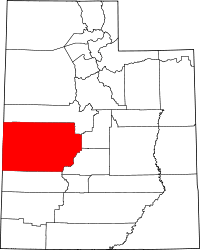Hatton, Utah
Hatton, formerly Petersburg, is a ghost town in Millard County, Utah. It lies at an elevation of 4,826 feet / 1,471 meters.[1]
History
In 1859, Peter Robison and Peter Boyce from Fillmore and other settlers from nearby, settled where the Mormon Road crossed Corn Creek 3 miles northwest of Kanosh's Pahvant village on the creek and downstream from the Corn Creek Indian Farm.[2]:166 The settlement was sometimes called Lower Corn Creek but was named Petersburg for Peter Robison, later its first post master. Boyce succeeded Anson Call as Indian agent at Corn Creek, appointed by Brigham Young. Petersburg was one of the larger stations and rest stops on the Gilmer and Salisbury Stage Company line from the Utah Southern Railroad rail-head in Juab County to the mining boom town of Pioche, Nevada from 1864 to 1871. Between 1867 and 1869, most of its inhabitants moved up stream to build the town of Kanosh at the original Pahvant village site. In 1869 the Petersburg schoolhouse was moved and reconstructed at Kanosh. From 1877 to 1940, Petersburg now a small agricultural settlement was renamed and had a post office called Hatton.[3]:86, 99–101, 114–117, 124, 129–130[4]:179
The Site today
This settlement is now a ghost town, with little to see of its past existence among the irrigated fields along Hatton Lane.[1]
References
- 1 2 U.S. Geological Survey Geographic Names Information System: Hatton
- ↑ Edward Leo Lyman, Chief Kanosh: Champion of Peace and Forbearance, Journal of Mormon History, Vol. 35, No. 1 (Winter 2009), pp. 157-207
- ↑ Edward Leo Lyman, Linda King Newell, A History Of Millard County, Utah State Historical Society, Millard County Commission, 1999
- ↑ John W. Van Cott, Utah Place Names: A Comprehensive Guide to the Origins of Geographic Names: a Compilation, University of Utah Press, Salt Lake City, 1990.
Coordinates: 38°50′20″N 112°27′24″W / 38.83889°N 112.45667°W
